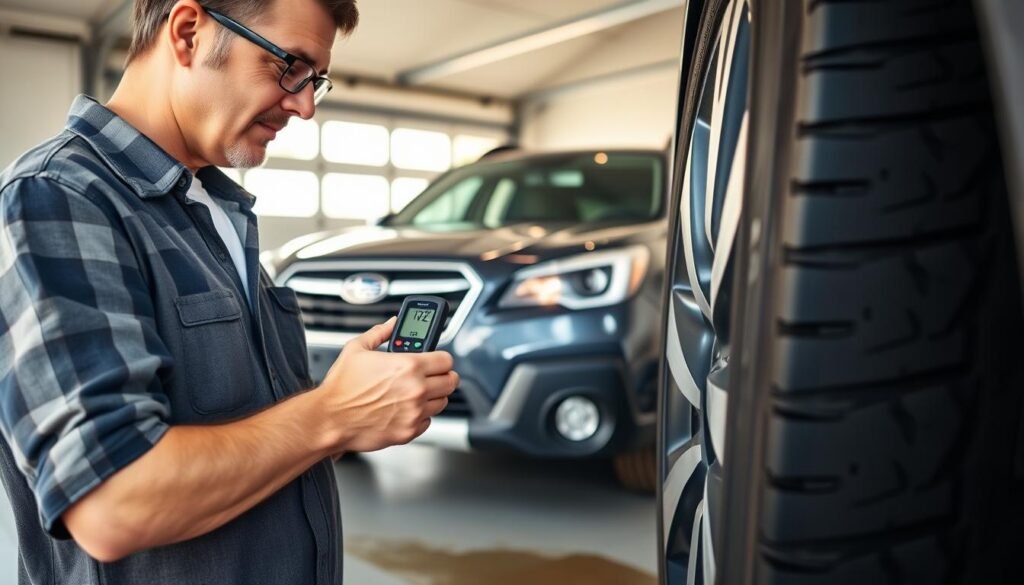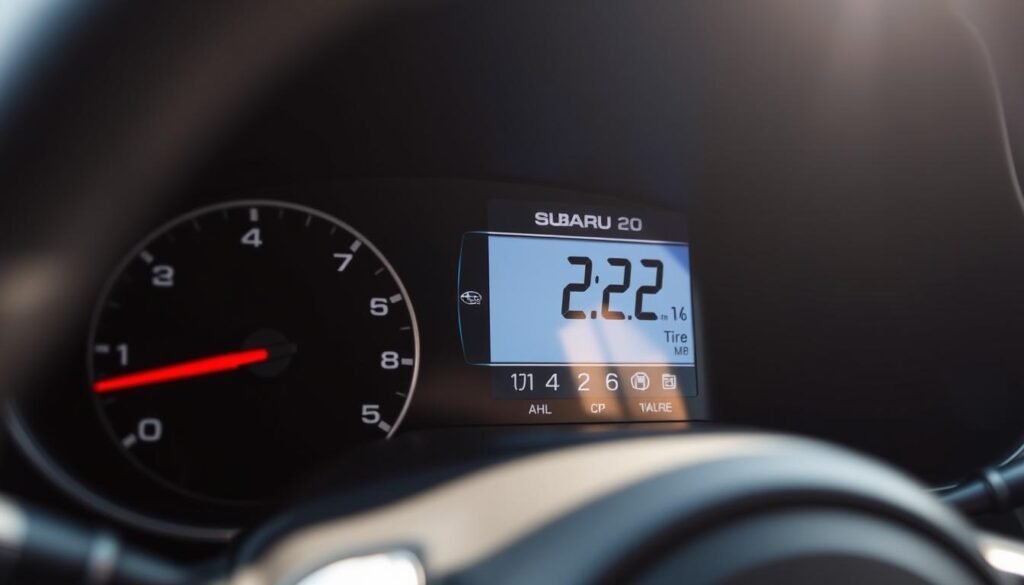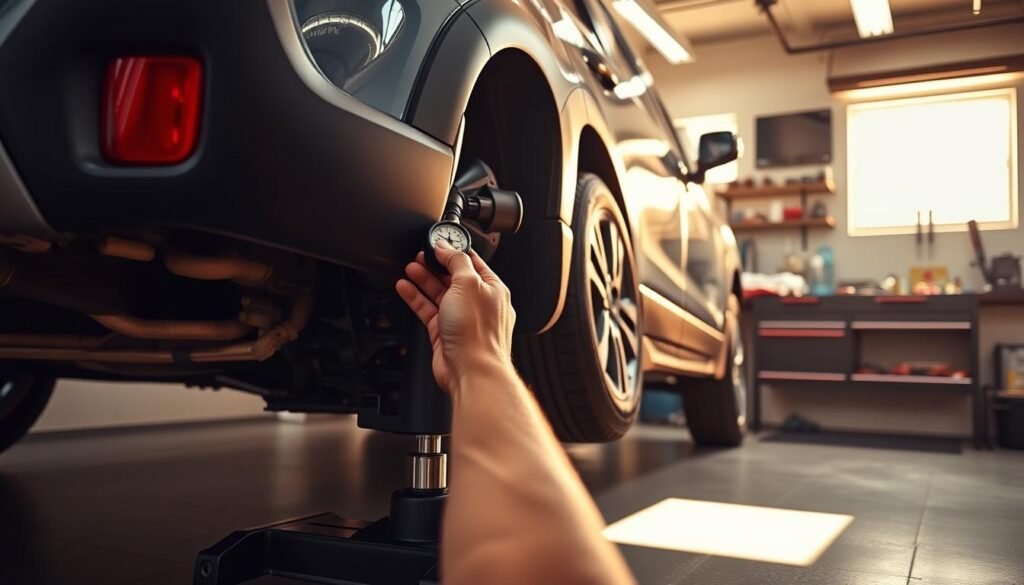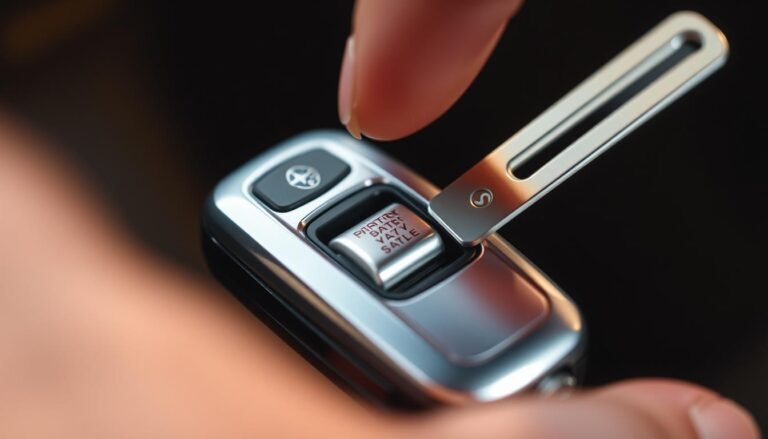Subaru Outback Tire Pressure Guide & Tips
The ideal tire pressure for your Subaru Outback is 35 PSI in front and 33 PSI in back when tires are cold. This is key for a smooth ride, better gas mileage, and long-lasting tires.
This guide offers insights on tire pressure, how to check and adjust it properly. It’s important to check your tires at least once a month and before long trips.
Changes in weather can affect tire pressure. For example, you should add about 1 PSI for every 10-degree drop.
This guide explains how to maintain the right tire pressure, deal with problems, and use the Tire Pressure Monitoring System (TPMS).
By following these tips, you can keep your Subaru Outback’s tires in great shape. This ensures your safety and the car’s efficiency on the road.
What’s Tire Pressure For Your Subaru Outback?
Tire pressure is how much air is in your tire. It’s measured in PSI (pounds per square inch). It’s key to keep your Subaru Outback safe and running smoothly.
The right tire pressure makes sure your car handles well and stays stable on the road. Many things can make tire pressure change. For example, temperature can change it.
For every 10 degrees Fahrenheit, tire pressure can go up or down by 1 PSI. So, in colder months, it’s important to check your Subaru Outback’s tire pressure often.
This helps avoid too low tire pressure. Usually, 35 PSI is right for the front tires of a Subaru Outback. And 33 PSI is right for the back tires when they are cold.
Always check the sticker near your door for the best advice for your car. Checking your tire pressure regularly can help you understand it better.
It also prevents problems like tire blowouts or using more fuel than you need to. Keeping the right tire pressure is super important for your car.
If tires are too low, they wear out faster and use more fuel. If they are too high, they wear unevenly and might blowout.
Knowing about tire pressure is very important. It affects how well your drive and how much you spend on car maintenance.
Recommended Subaru Outback Tire Pressure
Keeping the right tire pressure for your Subaru Outback is crucial for its best performance and safety.
It’s usually suggested to keep it between 32 and 38 PSI. The specific pressure should be 35 PSI in the front tires and 33 PSI in the back tires when they are cold.
Checking the pressure when the tires are cold, after the car hasn’t moved for a few hours, gives the most accurate results.
Cold Tire Pressure Specifications
Monitoring the cold tire pressure is key for your Subaru Outback’s top performance. Here are the normal cold tire pressures:
| Location | Recommended Pressure (PSI) |
|---|---|
| Front Tires | 35 |
| Rear Tires | 33 |
You should check your tire pressure at least every few weeks. Doing this helps you avoid tire wear and keeps you safe while driving.
Seasonal Adjustments For Tire Pressure
Adjusting tire pressure with the seasons is very important. Changes in temperature affect how inflated your tires are, requiring adjustments.
For every change of 10°F in temperature, you should adjust your tire pressure by 1 PSI. This helps your tires work their best, no matter the weather.

Keep an eye on your tire pressure monitoring system. Temperature shifts can turn on the warning light.
Adjusting your tire pressure for the season helps keep your Subaru Outback safe and running efficiently.
Importance of Proper Subaru Outback Tire Pressure
Keeping the right tire pressure is key for safe and efficient driving. It plays a huge role in how your Subaru Outback performs and how much gas it uses.
Checking and adjusting your tires regularly helps improve safety and the life of your vehicle.
Impact on Vehicle Performance
Correct tire pressure improves handling and stability of your Subaru Outback. Tires that are not inflated enough can blow out, putting safety at risk and possibly causing accidents.
Not having enough air in your tires also makes your car handle poorly and tires to wear out faster. Studies have shown that tires not properly inflated can wear out 25% quicker.
Keeping your tires within the 32-36 PSI range makes your ride smoother and safer.
Effects of Incorrect Tire Pressure on Fuel Efficiency
Having the wrong tire pressure affects fuel efficiency. Tires with the right amount of air can make your car use fuel 3% to 10% more efficiently.
If your tires don’t have enough air, they create more resistance, making your engine work harder and use more gas.
Experts say that for every 10°F drop in temperature, tire pressure goes down by 1 PSI. To keep your car running efficiently, especially when it’s cold, check your tires often.
Checking Your Subaru Outback Tire Pressure
Keeping the right tire pressure in your Subaru Outback is key for safety and how well it performs. It’s important to regularly check the tire pressure.
This avoids problems like tires wearing out unevenly and using more gas than needed. You’ll need a good tire pressure gauge made for the Subaru Outback.
How To Use a Tire Pressure Gauge?
Here’s how to check the tire pressure on your Subaru Outback:
- First, take off the cap on the tire’s valve stem.
- Push the tire pressure gauge onto the valve stem until it hisses. This means you’re getting the right reading.
- Look at the gauge to see the tire’s pressure. Check your owner’s manual for the right PSI.
- Don’t forget to put the valve stem cap back on after you’re done.
When To Check Tire Pressure?
It’s very important to watch the pressure in your tires often. Make sure to check it every month, particularly before you go on any long trips.
Changes in the weather can make tire pressure go up or down, so keep an eye on it when it gets warmer or colder.
If the temperature goes up or down by 10 degrees Fahrenheit, you should adjust your tire pressure by one PSI to keep it right.

Subaru Outback Tire Pressure Monitoring System
The Subaru Outback has a high-tech system that keeps tabs on tire pressure for your safety and to make sure your car runs well.
It uses sensors in each tire to watch pressure all the time. If a tire’s pressure is too low, a warning light on the dashboard comes on to tell you.
How It Works?
The tire pressure system in the Subaru Outback gets data from sensors in the tires. These sensors talk to the car’s computer to alert you if the pressure in any tire drops.
You should keep tire pressure between 32 and 38 PSI. For best performance, front tires should have about 35 PSI and rear tires about 33 PSI when cold.
Keeping an eye on tire pressure is key for your safety and to help your car run efficiently.
Knowing The Tire Pressure Warning Light
When the tire pressure warning light comes on, it means there might be a problem with the tires.
It’s important to check it out right away. If you ignore it, your car might use more fuel and the tires could wear out faster.
By checking tire pressure every month, you make sure the system works right and stays up-to-date with any issues.

Adjusting Tire Pressure in Your Subaru Outback
It’s vital to keep the right tire pressure for your Subaru Outback’s best performance and safety.
If your tires are low, it’s time to add air. By following a few steps, you can make sure your car runs well.
Steps To Inflate Your Tires
- Find a compressor or air tank that works for Subaru Outback tires.
- Take off the valve stem cap from the tire you’re inflating.
- Connect the air hose to the valve stem.
- Pump the tire to the suggested PSI, 35 for the front and 33 for the back. Keep checking the pressure to not overfill it.
What To Do If Pressure is Too Low?
If your tire pressure is too low, act fast. Low pressure affects how well your car drives and uses fuel. Inflate your tires using the guidelines above.
Check your owner’s manual or the driver’s side door frame for the right pressure if unsure.
Addressing Over-Inflation Issues
If your tires have too much air, it’s important to let some out. This prevents driving problems or tire bursts.
Use the release valve on your pressure gauge to let air out. Keep an eye on the pressure till it’s perfect.

Subaru Outback Tire Pressure Sensor Location
The Subaru Outback has a Tire Pressure Monitoring System (TPMS) important for tire health. The tire pressure sensors are usually in the valve stems of the wheels.
These sensors check the tire pressure non-stop and talk to the car’s computer for the best performance. It’s easy to find the tire pressure sensors.
They measure pressure every 30 seconds when the car moves. They then send this info to a module under the driver’s door about every minute at 7-20 mph.
Knowing where and how these sensors work is key to fixing tire pressure problems. The sensors’ batteries last around ten years or 100,000 miles, so checking them often is key.
The TPMS goes into ‘sleep’ mode if the car hasn’t moved in 15 minutes. A flashing TPMS light could mean there’s a problem, like if a wheel got changed without the original pressure sensor.
| Feature | Details |
|---|---|
| TPMS Standard | Required on all 2008 and newer models |
| Measurement Frequency | Every 30 seconds |
| Notification of Pressure Drop | Activates warning light at ~26-27 psi |
| Battery Life | Approximately 10 years or 100,000 miles |
| TPMS Sensor Sleep Mode | Enters sleep mode after 15 minutes of inactivity |
Knowing where your Subaru Outback’s tire pressure sensor is and keeping it in good condition is important.
It helps make your drive safer and your tires last longer. Keep an eye on the sensors to take good care of your vehicle.
Resetting The Subaru Outback Tire Pressure Light
Your Subaru Outback has a Tire Pressure Monitoring System (TPMS). It alerts you if the tire pressure is too low or if there’s a problem.
If the TPMS light comes on, it means a tire might be under-inflated. Knowing how to reset the tire pressure can fix the issue quickly.
Step-by-Step Reset Process
To reset the tire pressure light on your Subaru Outback, just follow these steps:
- Make sure all tires are filled to their recommended pressure. You can find the right pressure on the driver’s side door jamb or in your manual. Usually, it’s about 35 PSI for the front tires and 33 PSI for the back.
- Drive faster than 20 mph for a bit. This helps the system recalibrate and check the tire pressure again.
- If the TPMS light turns off after this, you’ve reset the tire pressure light successfully. If it stays on, you might have to look into it more.
If the light doesn’t go off, even with the right tire pressure, there might be a bigger issue. You may need to take your car to a dealership or tire shop.
Usually, it means there’s something wrong with a sensor, which many Subaru owners run into.
Common Issues with The Reset Process
Resetting the tire pressure light is usually easy, but sometimes problems come up. Here are some issues you might face:
- The TPMS light could stay on if there’s a big leak or a tire is completely flat.
- Cold weather can make tires lose pressure. For every 10°F it gets colder, tires can lose about 1 PSI.
- If the TPMS sensor blinks for a minute and then stays on, it’s broken. You’ll need to visit a dealer.
- Switching between seasonal tires on all-wheel drive models might require recalibrating the TPMS sensor.
Knowing these steps and potential issues helps you take care of your Subaru Outback’s tires. This ensures your car runs smoothly and safely on the road.
Subaru Outback Tire Pressure Tips For Maintenance
Keeping the right tire pressure in your Subaru Outback is key for best performance and safety. Checking tires regularly and taking good care of them makes driving better.
You get smoother handling, save on gas, and your tires last longer when you pay attention to their pressure.
Regular Maintenance and Monitoring
For a smooth drive, check your Outback’s tires once a month. This finds any pressure changes from weather or heavy items in your car.
Always remember these tire care hints:
- Check tire pressure when tires are cold for the most accurate readings.
- Follow Subaru’s recommendation to rotate tires every 6,000-7,500 miles.
- Inspect tires for cracks, bulges, and uneven tread wear regularly.
- Avoid overloading your vehicle to prevent uneven wear and compromised safety.
Seasonal Tire Care Tips
As the weather changes, so does your tire care strategy. Adjust your Subaru Outback’s tire pressure for the season to keep it right.
Remember, tire pressure goes down when it gets colder, and you’ll need to adjust. Keep these seasonal pointers in mind:
- Check tire pressure before long trips, especially when transitioning into different weather conditions.
- Increase tire pressure by one PSI for every 10 degrees Fahrenheit temperature drop.
- Be mindful of aggressive driving behaviors that can accelerate tire wear.
Conclusion
Keeping the right tire pressure is key for your Subaru Outback’s performance, safety, and life span.
This conclusion stresses needing to stick to the pressure levels made for your vehicle’s model year.
Managing your tire pressure well improves how your car drives, its comfort, and gas mileage.
It’s smart to check your tires every month to spot any issues right away. Knowing how to adjust the pressure with the seasons and how your TPMS system works is crucial.
Always keep an eye on your tire’s condition, just like we’ve discussed in this guide. At the end of the day, taking good care of your tire pressure is vital.
It not only makes driving better but also helps your tires last longer. Every Subaru Outback owner should consider it a key part of looking after their car.
FAQs
What is the recommended tire pressure for a Subaru Outback?
You should pump the Subaru Outback’s front tires to 35 PSI and the rear to 33 PSI when cold.
How can I check my Subaru Outback’s tire pressure?
Checking tire pressure is easy. Just grab a reliable gauge and attach it to the valve stem. Don’t forget to replace the cap after checking. It’s good to do this every month and before any long trips.
What should I do if my tire pressure warning light comes on?
If you see the tire pressure warning, check your tires with a gauge right away. Fill any that are low to the proper PSI. Then, you may need to reset the warning light.
How does the Tire Pressure Monitoring System (TPMS) work?
TPMS keeps an eye on your tires for you. It uses sensors in the tires to tell you if the pressure drops.
Where are the tire pressure sensors located on a Subaru Outback?
The sensors for tire pressure are in the valve stems of each wheel on the Subaru Outback.
How can I reset the tire pressure light on my Subaru Outback?
Resetting the light is simple. Make sure your tires have the right amount of air, then drive at 20 mph or more. The system checks everything again and turns the light off if it’s all good.
What should I do if my tires are over-inflated?
If your tires have too much air, just let some out using the gauge’s relief valve. Keep going until you hit the right PSI.







